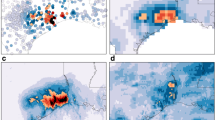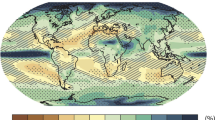Abstract
The conventional approach to detecting and attributing climate change impacts on extreme weather events is generally based on frequentist statistical inference wherein a null hypothesis of no influence is assumed, and the alternative hypothesis of an influence is accepted only when the null hypothesis can be rejected at a sufficiently high (e.g., 95% or “p = 0.05”) level of confidence. Using a simple conceptual model for the occurrence of extreme weather events, we show that if the objective is to minimize forecast error, an alternative approach wherein likelihoods of impact are continually updated as data become available is preferable. Using a simple “proof-of-concept,” we show that such an approach will, under rather general assumptions, yield more accurate forecasts. We also argue that such an approach will better serve society, in providing a more effective means to alert decision-makers to potential and unfolding harms and avoid opportunity costs. In short, a Bayesian approach is preferable, both empirically and ethically.




Similar content being viewed by others
References
Allen M (2011) In defense of the traditional null hypothesis: remarks on the Trenberth and Curry WIREs opinion articles. WIREs Clim Change 2:931–934. doi:10.1002/wcc.145
Anderegg WR, Callaway ES, Boykoff MT, Yohe G, Root TYL (2014) Awareness of both type 1 and 2 errors in climate science and assessment. Bull Am Meteorol Soc 95:1445–1451
Bellprat O, Doblas-Reyes F (2016) Attribution of extreme weather and climate events overestimated by unreliable climate simulations. Geophys Res Lett 43:2158–2164
Berliner LM, Levine RA, Shea DJ (2000) Bayesian climate change assessment. J Clim 13:3805–3820
Berry DA (1987) Interim analysis in clinical trials: the role of the likelihood principle. Amer Stat 41:117–122
Bindoff NL, Stott PA, Achuta Rao KM, Allen MR, Gillett N, Gutzler D, Hansingo K, Hegerl G, Hu Y, Jain S, Mokhov II, Overland J, Perlwitz J, Sebbari R, Zhang X (2013) Detection and attribution of climate change: from global to regional. In: Stocker TF, Qin D, Plattner G-K, Tignor M, Allen SK, Boschung J, Nauels A, Xia Y, Bex V, Midgley PM (eds) Climate change 2013: the physical science basis. Contribution of working group I to the fifth assessment report of the intergovernmental panel on climate change. Cambridge University Press, Cambridge
Blanchet J, Davison AC (2011) Spatial modeling of extreme snow depth. Ann Appl Stat 5:1699–1725
Brysse K, Oreskes N, O’Reilly J, Oppenheimer M (2013) Climate change prediction: erring on the side of least drama? Glob Environ Chang 23(1):327–337
Cooley D, Nychka D, Naveau P (2007) Bayesian spatial modeling of extreme precipitation return levels. J Am Stat Assoc 102(479):824–840, Applications and case studies. doi:10.1198/016214506000000780
Curry JA (2011) Nullifying the climate null hypothesis. WIREs Clim Change 2:919–924. doi:10.1002/wcc.141
Diffenbaugh NS, Swain DL, Touma D (2015) Anthropogenic warming has increased drought risk in California. Proc Natl Acad Sci U S A 112(13):3931–3936. doi:10.1073/pnas.1422385112
Francis JA, Vavrus SJ (2012) Evidence linking Arctic amplification to extreme weather in mid-latitudes. Geophys Res Lett 39:L06801. doi:10.1029/2012GL051000
Gigerenzer G, Edwards A, (2003) Simple tools for understanding risks: from innumeracy to insight, British Medical Journal, 327, 741–744
Gigerenzer G, Switjink Z, Porter T, Daston L, Beatty J, Kruger L (1989) The empire of chance: how probability changed science and everyday life. Cambridge University Press, Cambridge
Hegerl GC, Hoegh-Guldberg O, Casassa G, Hoerling MP, Kovats RS, Parmesan C, Pierce DW, Stott PA (2010) Good practice guidance paper on detection and attribution related to anthropogenic climate change. In: Stocker TF, Field CB, Qin D, Barros V, Plattner GK, Tignor M, Midgley PM, Ebi KL (eds) Meeting report of the intergovernmental panel on climate change expert meeting on detection and attribution of anthropogenic climate change. IPCC Working Group I Technical Support Unit, University of Bern, Bern p 8
Herring SC, Hoerling MP, Kossin JP, Peterson TC, Stott PA (2015) Explaining extreme events of 2014 from a climate perspective. Bull Am Meteorol Soc 96(12):S1–S172
IPCC (2013) Summary for policymakers. In: Stocker TF, Qin D, Plattner G-K, Tignor M, Allen SK, Boschung J, Nauels A, Xia Y, Bex V, Midgley PM (eds) Climate change 2013: the physical science basis. Contribution of working group I to the fifth assessment report of the intergovernmental panel on climate change. Cambridge University Press, Cambridge
Lewandowsky S, Oreskes N, Risbey JS, Newell BR, Smithson M (2015) Seepage: climate change denial and its effect on the scientific community. Glob Environ Chang 33:1–13. doi:10.1016/j.gloenvcha.2015.02.013
Meehl GA, Arblaster JM, Tebaldi C (2007) Contributions of natural and anthro-pogenic forcing to changes in temperature extremes over the U.S. Geophys Res Lett 34:L19709. doi:10.1029/2007GL030948
National Research Council (2016) Attribution of extreme weather events in the context of climate change. National Academies Press, Washington, DC
Nuzzo R (2014) Scientific method: statistical errors. Nature 506:150–152
Oppenheimer M, Oreskes N, Jamieson D, Brysse K, O’Reilly J, Shindell M, (2017) Assessing assessments: scientific knowledge for public policy, University of Chicago Press. (forthcoming)
Oreskes N, Shrader-Frechette K, Belitz K (1994) Verification, validation, and confirmation of numerical models in the earth sciences. Science 263:641–646
Otto FEL, Massey N, van Oldenborgh GJ, Jones RG, Allen MR (2012) Reconciling two approaches to attribution of the 2010 Russian heat wave. Geophys Res Lett 39:L04702. doi:10.1029/2011GL050422
Peterson T, Stott P, Herring S (2012) Explaining extreme events of 2011 form a climate change perspective. Bull Am Meteorol Soc 93(7):1041–1067
Rahmstorf S, Cazenave A, Church JA, Hansen JE, Keeling RF, Parker DE, Somerville RC (2007) Recent climate observations compared to projections. Science 316(5825):709–709
Shepherd TG (2014) Atmospheric circulation as a source of uncertainty in climate change projections. Nat Geosci 7:703–708
Shepherd TG (2016) A common framework for approaches to extreme event attribution. Curr Clim Change Rep 2(1):28–38. doi:10.1007/s40641-016-0033-y
Stott PA, Allen M, Christidis N, Dole RM, Hoerling M, Huntingford C, Pall P, Perlwitz J, Stone D (2013) Attribution of weather and climate-related events. In: Asrar GR, Hurrell JW (eds) Climate science for serving society. Springer, Haarlem, pp 307–337
Stott P, Christidis N, Otto FEL, Sun Y, Vanderlinden J-P, van Oldenborgh GJ, Vautard R, von Storch H, Walton P, Yiou P, Zwiers FW (2016) Attribution of extreme weather and climate-related events. Wiley Interdiscip Rev Clim Chang 7(1):23–41. doi:10.1002/wcc.380
Trenberth KE (2011) Attribution of climate variations and trends to human influences and natural variability. WIREs Clim Change 2:925–930
Trenberth KE (2012) Framing the way to relate climate extremes to climate change. Clim Chang 115:283–290
Trenberth KE et al (2015) Attribution of climate extreme events. Nat Clim Chang 5:725–730
Acknowledgements
We thank James V. Stone, Psychology Department, Sheffield University, Sheffield, England for kindly posting the Bayesian coin flipping routine (MatLab code version 7.5. downloaded from http://jim-stone.staff.shef.ac.uk/BayesBook/Matlab). We thank two anonymous reviewers for the helpful comments on the initial draft of this article.
Author information
Authors and Affiliations
Corresponding author
Additional information
A comment to this article is available at doi:10.1007/s10584-017-2049-2
Electronic supplementary material
Fig. S1
(DOCX 73 kb)
Rights and permissions
About this article
Cite this article
Mann, M.E., Lloyd, E.A. & Oreskes, N. Assessing climate change impacts on extreme weather events: the case for an alternative (Bayesian) approach. Climatic Change 144, 131–142 (2017). https://doi.org/10.1007/s10584-017-2048-3
Received:
Accepted:
Published:
Issue Date:
DOI: https://doi.org/10.1007/s10584-017-2048-3




